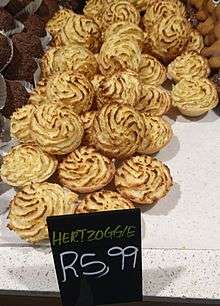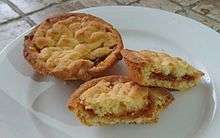Hertzoggie
 Hertzoggies being sold in a South African bakery for R5.99 (roughly US$0.42) each. | |
| Course | Dessert |
|---|---|
| Place of origin | South Africa |
| Creator | unknown |
| Invented | 1920s |
| Main ingredients | Flour, salt, butter or margerine, sugar, eggs, apricot jam, baking soda, desiccated coconut |
| Variations | Multiple |
|
| |
A Hertzoggie, also known in Afrikaans as a Hertzog Koekie or in English as a Hertzog Cookie, is a jam-filled tartlet or cookie with a coconut topping commonly served on a cup-like pastry base.
The cookie is a popular dessert in South Africa where it is often eaten with a cup of English tea. In the Cape-Malay community the dessert is often eaten during Eid.[1] It is often baked at home as part of a dessert-baking cottage industry in the country and sold alongside other popular South African desserts such as Koeksisters.
History
The tartlet is named after the early 20th century South African politician and Boer War General J. B. M. Hertzog. The Hertzog Koekies are thought to have been a favorite of his.[1] Hertzog's supporters were known to have baked and served them to show their political support.[2][3]
One story of the origin of the dessert states that it was invented by the Cape-Malay community to demonstrate their support for Hertzog after he promised to give women the vote and equal rights to the coloured community in the 1920s. After fulfilling the first promise to give women the vote in 1930, but not the second, the community began baking the cookies with a brown and pink icing called "twee gevreetjie" (Afrikaans for "hypocrite"), showing their dissatisfaction with him.[4][3]
Another possible source for the dessert's origin is the Afrikaans practice following the Second Anglo-Boer War to name confections after national heroes.[5]
Composition
Hertzog Koekies are prepared from a pastry base with an open top that is filled with apricot jam. It is topped with a desiccated or grated coconut meringue topping and baked.[6][7]
Jan Smuts cookies

The Hertzog Koekie inspired supporters of Hertzog's political rival and contemporary Jan Smuts to bake a version of their own called "Jan Smuts cookies". This confection also became popular in the 1920s and 1930s.[1][7] Jan Smuts cookies have a creamed butter and sugar topping instead of the paler meringue topping of the Hertzog Koekie.[8]
See also
• Koeksister
• List of African dishes
References
- 1 2 3 Breakfast, Swellendam Guesthouse B&B | Augusta de Mist | Garden Route Accommodation | Bed and (2012-08-19). "Have another Hertzoggie!". Retrieved 2016-07-22.
- ↑ "Hertzoggies – The Political Food Show". 2016-02-26. Retrieved 2016-07-22.
- 1 2 Baderoon, Gabeba (2014). Regarding Muslims: From Slavery to Post-Apartheid. Johannesburg: Wits University Press. p. 93. ISBN 9781868147694.
- ↑ Baderoon, Gabeba (2007). "'Catch with the eye': stories of Muslim food in Cape Town" (PDF). In Field, Sean; Meyer, Renate; Swanson, Felicity. Imagining the City: Memories and Cultures in Cape Town. HSRC Press. p. 130. ISBN 978-0-7969-2179-6.
- ↑ Sarah Emily Duff (28 February 2016). Hertzoggies: Extended Interview with Sarah Emily Duff (Podcast). 10:58: Political Foods.
- ↑ "Hertzoggies (Cookies!)". Food.com. 2006. Retrieved 22 July 2016.
- 1 2 "Old fashioned Hertzoggies". Pink Polkadot Food. 20 December 2012. Retrieved 22 July 2016.
- ↑ Goldberg, Doreen. "How the cookie crumbles". Times LIVE. Retrieved 2016-07-22.